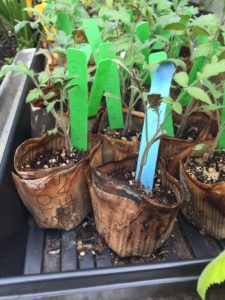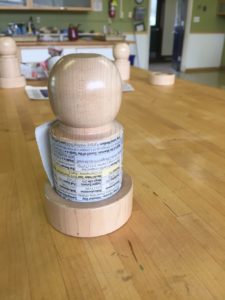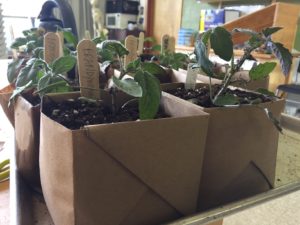Like so many things in gardening and in life, I have come late to many wonderful ideas. And yet I give thanks for having stumbled upon them, realizing, in the words of the Chinese proverb, that although the best time to plant a tree was 20 years ago, the next best time is now.
The humble newspaper pot. Sturdier than I had thought and apparently the tomato doesn’t mind the lowly digs.
The used-newspaper planting pot was not news to me. I had seen the maple dowels for forming them in sundry garden catalogs over the years, and, though I admired them for their crafty re-use of newspaper, I thought it was a bit silly….a project for the kids and nothing more. Clearly newspaper wouldn’t make a very good planting pot, would it? Shame on me for judging without trying.
Now if Portland had not had one of its rainiest springs ever this year, I don’t know if I would have disabused myself of those thought errors. As a garden educator I was desperate to find enough things to do indoors as we were pummeled with rain after rain through February, March, and April. Stopping by a nursery one day I saw the maple pot-makers for sale and thought, “What the heck. The kids will enjoy making these, and (most crucial) we can do it indoors.”
This clean, hardwood object which is utterly simple and long-lasting seems to squarely contradict the forces of consumerism. It can’t break, will give lifetime service, and has no glitz. That is a good thing to align oneself with as a gardener!
After a little trial and error to figure out the correct-sized strip of newspaper to roll around the dowel and compress with the base, we were off and running, and a few weeks into our planting experiments, I am impressed that the pots seem pretty sturdy. True, the newspaper does get soggy, and you wouldn’t want to be handling or transferring them on a daily basis, but I have been pleasantly surprised that the things don’t just disintegrate or fall apart. They sit in a planting tray pressing up against each other, and although regular watering cannot but weaken them, it is also true that the roots of the transplants will eventually bind the soil together and strengthen them.
For the past few years at school I have been using coco-pots, which are of course biodegradable (though they do maintain their shape for some years in the soil) and which allow plants’ roots to grow right through their sides when buried. But as “eco” as they are, they still cost 15 or so cents each. How much better to use a free material which also biodegrades and which, conveniently, is delivered to my front. (The sad state of The Oregonian, and of so many papers nationwide, is that if they are even printed anymore, they have become attenuated – mine sometimes looks more like a pamphlet or flyer. That and The Oregonian went from being a daily to a 4-times-a-week paper. I am resigned that sooner or later this post will be irrelevant because there won’t be any more newspapers!)
The planting pot that the dowel makes is about 2″ high and about 1.5″ wide. It’s great for smaller starts, like lettuce, or for about 6 weeks’ growth of starts destined for bigger pots: tomatoes, peppers, and eggplant, for instance. Since I was so pleased with the results of this low tech item, I began looking for the larger size, though I suspected that the strength-to-size ratio of newspaper may favor keeping these pots small. I was wrong again! A quick search on youtube revealed that there are folks who simply use whatever size tin can they need for the final size of their pot and an appropriate length/thickness of newspaper.
Are you ready to graduate from the rolled newspaper pot? Then welcome to the world of the origami box….perfect for the larger transplants like tomato, eggplant, and pepper. I made these with heavy duty craft paper.
While the large-can approach intrigued me, I was much more taken with the idea of making a box-like pot, possible through the wonders of origami. For the next round of garden lessons (yes, indoors, because, yes, still raining in Portland) I bought myself some sturdy craft paper at the local Big Box and trialed a number of dimensions. I arrived at near perfect 4″ paper cube by starting with a 12″ x 16″ sheet. The children loved making these pots, and even I continued long after class was over, partly because I still had a lot of tomatoes to transplant and partly because I immersed myself in the craftiness of these marvelous objects.
Below are two helpful links that will show you how to make a newspaper pot with a maple dowel press and how to fold an origami “strong box”.
https://www.youtube.com/watch?v=8_ynv89F_Ik
https://www.youtube.com/watch?v=7dlGQP81yfo
Plastic will always be with us, and admittedly it is cheap and easy, but I rejoice in knowing there are paper alternatives that are satisfactorily strong, totally biodegradable, and crafty and fun to make.
Maple dowel pot-making kits are available from Amazon:
https://www.amazon.com/Do-It-Yourself-Plant-PotMaker-from-Newspaper/dp/B007K45A7C
Also, as far as forms go, a wine bottle with an indented bottom works pretty well!
As for newspapers….good luck finding those these days!



